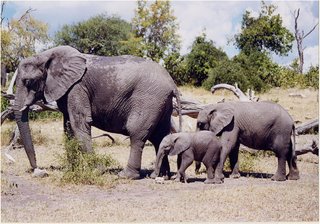More about elephants. This article from Yahoo caught my eye after reading the earlier NYTimes article. They did what is called the "mirror test," where they put an elephant-sized mirror in the elephant cage and watched what they did. The elephants appeared to use the mirror like a person would, looking at themselves, and didn't think the image in the mirror was another animal but recognized it as a reflection.
http://news.yahoo.com/s/ap/20061031/ap_on_sc/self_aware_elephant
I've always thought elephants were remarkable creatures, but didn't count myself as one of the worlds biggest fans. Now, with the information that is coming out, I really wonder if we have been slaughtering one of the smartest creatures on earth to carve their teeth into trinkets. I've always supported the ban on ivory, but now I think there is a lot more we should do to help elephants. There have been recent reports describing the horrific impact climate change is going to have on the human populations in Africa, but we should also consider the impact on other species there, too.
http://news.yahoo.com/s/ap/20061031/ap_on_sc/self_aware_elephant
I've always thought elephants were remarkable creatures, but didn't count myself as one of the worlds biggest fans. Now, with the information that is coming out, I really wonder if we have been slaughtering one of the smartest creatures on earth to carve their teeth into trinkets. I've always supported the ban on ivory, but now I think there is a lot more we should do to help elephants. There have been recent reports describing the horrific impact climate change is going to have on the human populations in Africa, but we should also consider the impact on other species there, too.

